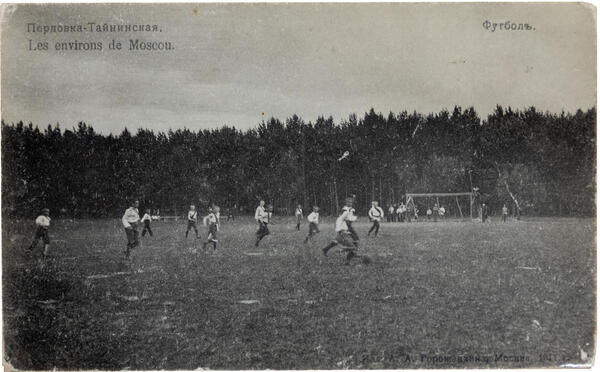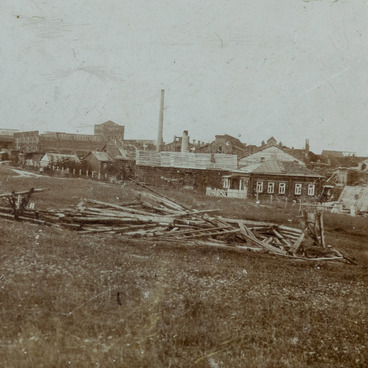The postcard depicts a game of soccer; the photo was taken in 1911. One can distinguish players, the goal, and even the apparel.
About a century ago, Mytishchi got its first sports grounds and amateur sports teams. It was all thanks to the ‘dacha (summer house) boom’ of the early 20th century in the Moscow Region. Owners of the dacha communities established back in the 19th century, such as Losinoostrovskaya, Perlovka, Mamontovka, and Pushkino, wanted to provide the rich countryside residents with maximum comfort and attract more house buyers with all kinds of entertainment.
And one of the most popular types of hobbies in the early 20th century was soccer. The first soccer teams in Perlovka were: Perlovka, whose lineup consisted of dacha residents, and Sparta that was formed later in Bolshie Mytishchi. In 1913, both teams were in the Moscow Soccer League and played games of the Yaroslavl Railroad League, which included the teams of Bolshevo, Shchyolkovo, Losinoostrovskaya, Cherkizovo, Klyazma, and Pushkino. The Perlovka team trained on the field near the railroad platform while Sparta had their own field in Mytishchi.
The lineup was very diverse: children of public officials, students of Moscow technical schools and colleges, heirs of nearby factories and plants. Amateur teams raised players for Moskva and, later, for the first Russian national team that traditionally competed in the Russian championship games along with the Peterburg team. The defender of the Pushkino dacha team Mikhail Romm became the captain in Moskva and then the captain of the first Russian national team. They played in the 1912 Olympics in Stockholm, which was the first for this country’s athletes.
It wasn’t an easy task to find a field suitable for soccer because all large flat areas were already used as pastures by the farmers. So, soccer players had to rent them for a sizable price. Still, in 1913 newspapers heralded the start of ‘the era of soccer when we have lots of matches on every public holiday.’ This led to certain difficulties. For example, there was a high demand for referees that virtually did not exist, so the judges were selected from among the most qualified players of the Moscow Soccer League.
Besides, when factory owners wanted to create a team he usually picked players from among his workers. Because of this, some games looked like fist-fighting rather than a sports match. Sports fans regretfully admitted that more than once local merchant patrons paid players a certain amount of money for each goal they made. Betting was popular, and even players sometimes participated in it. After each match, they calculated how much each player got for one goal, for winning, for a difference of two or three goals.
The price of tickets for a match was defined by the class of the teams that played and by the field. In most cases, numbered seats cost 1 ruble 50 kopecks each, and a general admission ticket was 80 kopecks.
About a century ago, Mytishchi got its first sports grounds and amateur sports teams. It was all thanks to the ‘dacha (summer house) boom’ of the early 20th century in the Moscow Region. Owners of the dacha communities established back in the 19th century, such as Losinoostrovskaya, Perlovka, Mamontovka, and Pushkino, wanted to provide the rich countryside residents with maximum comfort and attract more house buyers with all kinds of entertainment.
And one of the most popular types of hobbies in the early 20th century was soccer. The first soccer teams in Perlovka were: Perlovka, whose lineup consisted of dacha residents, and Sparta that was formed later in Bolshie Mytishchi. In 1913, both teams were in the Moscow Soccer League and played games of the Yaroslavl Railroad League, which included the teams of Bolshevo, Shchyolkovo, Losinoostrovskaya, Cherkizovo, Klyazma, and Pushkino. The Perlovka team trained on the field near the railroad platform while Sparta had their own field in Mytishchi.
The lineup was very diverse: children of public officials, students of Moscow technical schools and colleges, heirs of nearby factories and plants. Amateur teams raised players for Moskva and, later, for the first Russian national team that traditionally competed in the Russian championship games along with the Peterburg team. The defender of the Pushkino dacha team Mikhail Romm became the captain in Moskva and then the captain of the first Russian national team. They played in the 1912 Olympics in Stockholm, which was the first for this country’s athletes.
It wasn’t an easy task to find a field suitable for soccer because all large flat areas were already used as pastures by the farmers. So, soccer players had to rent them for a sizable price. Still, in 1913 newspapers heralded the start of ‘the era of soccer when we have lots of matches on every public holiday.’ This led to certain difficulties. For example, there was a high demand for referees that virtually did not exist, so the judges were selected from among the most qualified players of the Moscow Soccer League.
Besides, when factory owners wanted to create a team he usually picked players from among his workers. Because of this, some games looked like fist-fighting rather than a sports match. Sports fans regretfully admitted that more than once local merchant patrons paid players a certain amount of money for each goal they made. Betting was popular, and even players sometimes participated in it. After each match, they calculated how much each player got for one goal, for winning, for a difference of two or three goals.
The price of tickets for a match was defined by the class of the teams that played and by the field. In most cases, numbered seats cost 1 ruble 50 kopecks each, and a general admission ticket was 80 kopecks.



